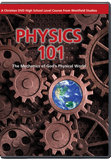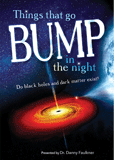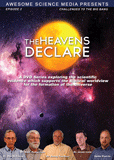Is This Science?
When modern evolutionary physicists begin to connect the dots with abstract ideas—such as string theory—that can’t be tested, even they are alarmed. Can they really call this science?
It’s Official
Physics has hit its awkward teenage years. After establishing many fundamentals and enjoying several major growth spurts, physics has reached the age of lost confidence. It is now unsure of itself and its own “cold, hard facts.” Or, at least, leading physicists are feeling this way. In their scramble to reduce all of life to physical explanations and reasonings, they have run into something of an identity crisis.
The favorite pets of modern theoretical physicists—such as string theory, loop quantum gravity, and multiple universes—are so theoretical that they may never be testable. This conundrum has forced scientists to reexamine the basic questions, what is science, and is this science?
In the effort to understand the underlying nature of reality, theoretical physics has run into challenges that are so abstract that the scientists are no longer able to provide concrete, testable predictions about the world. They describe conditions that we may never be able to replicate on this planet.
The problem came to a head in December 2014, when a landmark paper in Nature, “Scientific Method: Defend the Integrity of Physics,” warned: “This year, debates in physics circles took a worrying turn. Faced with difficulties in applying fundamental theories to the observed Universe, some researchers called for a change in how theoretical physics is done. They began to argue—explicitly—that if a theory is sufficiently elegant and explanatory, it need not be tested experimentally, breaking with centuries of philosophical tradition of defining scientific knowledge as empirical.”
The authors threw down the gauntlet. And a slew of articles, books, and conferences followed.
One book, released in 2016, was shockingly titled Fashion, Faith, and Fantasy in the New Physics of the Universe. The author, eminent theoretical physicist Roger Penrose, worried that too many people were equating theories that work on paper with reality. Nature’s review of the book was aptly titled, “The Emperor’s New Physics.”
A major conference in December 2015 brought together physicists and philosophers to address the problem. “At stake is the integrity of the scientific method,” Nature reported about the organizers’ motives, “as well as the reputation of science among the general public.”
This debate affects everyone. It concerns what’s real and whom we trust to tell us.
This debate affects everyone. It concerns what’s real and whom we trust to tell us. After three centuries of enthroning science as our ultimate authority, scientists are investigating these basic issues again.
How ironic. The modern scientific method helped give birth to the modern way of thinking: we don’t need God to help explain reality. But now scientists can’t even agree among themselves.
God made clear in his Word where reality comes from. Jesus Christ “created the world” and he “upholds the universe by the word of his power” (Hebrews 1:3). Any effort to explain the ultimate nature of reality without acknowledging him as the originator and the sustaining power of the universe is doomed to failure.
That’s a sobering lesson for all of us. Secular scientists are discovering more and more about the marvelous, infinite complexity of the universe, but they are still in the dark about the ultimate explanation for nature and its laws, “always learning and never able to arrive at a knowledge of the truth,” as Paul so eloquently put it (2 Timothy 3:7).
Two Modern Theories of Reality, Both Accepted But Irreconcilable
You don’t have to know physics to understand what’s happening. After three centuries in which science has been revered as the ultimate source of hope and understanding about reality, the leaders in the “hard sciences” are admitting that they still can’t reconcile their various theories about physics. Some underlying, unifying principle still eludes them.
The physics of early greats like Galileo and Newton described everyday life as we experience it, but later scientists like Einstein realized that their fine mathematical equations couldn’t explain special cases. Two branches of physics arose to explain the very big (on the scale of stars and the travel of starlight) and the very small (the interaction between energy and the smallest particles).
Einstein’s theory of general relativity tried to explain the large-scale motion of stars and the universe, while quantum field theory attempted to explain the behavior of tiny particles.
From the beginning, however, scientists recognized that these theories didn’t work together.
In reviewing four books that came out at the end of 2016, New Scientist summarized this problem well: “In one sense fundamental physics is flowering like never before. In another, it is in one of its deepest funks.”
Recent discoveries, such as gravitational waves, have confirmed quantum field theory (the basis for the standard model of particle physics) and the theory of general relativity (the basis for the standard cosmological model). Yet, the New Scientist article goes on to say, “Not only do they contradict each other, they contradict how we feel reality should behave.”
The problem goes back to the basic issue that troubled Newton. Gravity. It just does not want to play nice with others.
Quantum mechanics describes how atoms, electrons, and the smaller bits of reality behave. When a lightbulb releases a stream of light, it’s not actually a steady stream. The light goes out in “packets” (or quanta, hence the name quantum mechanics). The atoms that produce different colors of light require specific amounts of energy, like gift boxes.
What does this have to do with gravity? Gravity cannot be broken into gift boxes the way energy can. As far as we currently understand, gravity is a smooth, continuous force felt throughout the space-time continuum. This stark incompatibility has plagued physicists for over a hundred years. This gave rise to the chase after the “theory of everything,” a way to explain quantum mechanics and general relativity both under one grand description.
Except, it turns out it’s not so easy, and some weird things started to happen.
Chase for a Theory of Everything
String Theory
For a number of years, string theory has been one of the hottest ideas in theoretical physics. String theory postulates that the particles that combine to form electrons, protons, and neutrons are themselves made of vibrating, one-dimensional strings. Furthermore, this theory means that our universe has at least six additional dimensions to the three spatial and one time dimension that we’re all familiar with. And you thought light as packages was strange.
If you imagine these strings folding in on themselves, vibrating at differing frequencies, not only does the universe turn into an ongoing orchestra, but these strings allow the math to describe both quantum interactions and gravity.
This elegant theory, which only a mathematician could properly appreciate, has a couple of problems (more than a couple, actually). One is that it can’t be tested, as far as we know. Another is that it leads to some other really bizarre predictions, such as the existence of a virtually infinite number of universes (10500).
Loop Quantum Gravity
Unsurprisingly, not everyone is convinced that string theory is the best way to describe the universe. The next best explanation is called loop quantum gravity. This takes a wildly different approach from string theory. Its supporters suggest that more than subatomic particles exist in discrete “packets” (quanta). What if space itself is a discrete packet? What if things move in discrete distances (and they can’t move shorter distances than that)? In other words, if you try to take a shorter and shorter step, there comes a point where you can’t walk another “half a step.”
This theory describes space as a finely woven tapestry of finite loops. Indeed, the thing we call “space” has a structure like an atom. Sound weird? Hard to understand? Physics takes us to these weird places when it tries to put all the pieces together.
In this description of reality, where space is like a woven blanket as opposed to a smooth expanse, gravity can also be broken down into smaller amounts. This would allow both general relativity and quantum mechanics to work together. Huzzah! We have an answer. Theoretically.
This theory has its own problems. It’s not yet testable. And it seems to conflict with the smoothness of reality. We know that glass, though it appears smooth, is actually made of imperfectly joined molecules. But nobody has ever seen smaller pieces of space; nor do we know how to look for them.
The Limits of Science
The math may be elegant, the reasoning consistent, but these new theories cannot be proved without being tested. And they cannot be tested. Some physicists are beginning to wonder whether they should be considered science at all, while some of their supporters argue that science needs to move away from such an unhelpful over-dependence on experimental physics.
At the major workshop mentioned earlier in the article, which brought together some of the greatest scientific and philosophical minds in the world, two perspectives arose on science. In the opening talk, David Gross, a theoretical physicist at the University of California, Santa Barbara, argued that just because a theory cannot be tested now doesn’t mean it will never be able to be tested. The atomic theory was proposed a hundred years before we had the technology to observe objects that small. Why should string theory be treated differently?
Furthermore, he argued, we like to explain the scientific method as a rigorous testing of hypotheses, but that isn’t how great advances in science have historically worked. Einstein, for instance, came up with the theory of general relativity because he believed that’s how the world should work rather than by observation and experimentation.
The other side fell back on a defense of empirical testability and experimentation, spelled out in the 1930s by a secular, materialist philosopher named Karl Popper. He wanted to reduce science to a testable series of claims that could be falsified, and he hoped to define science that way.
The problem goes deeper than asking whether there’s a place for untestable speculation. Few philosophers or scientists would dispute that. The problem is whether physics (and science) is equipped to answer some fundamental questions.
Indeed, mathematicians proved back in the 1930s, using the basic elements of logic and math, that mathematical models will always be incomplete. Every model must depend on outside assumptions that it cannot prove. This is known as Gödel’s incompleteness theorem.
The problem isn’t with the physics but with the limits of trying to explain existence without God.
New Scientist, when it reviewed the latest books on this subject, summarized the dilemma well with these concluding words: “Ultimately, physics only describes the part of reality that is susceptible to mathematics . . . No doubt physics is important, but it could be there is much that is important about reality that is not physics.”
The problem isn’t with the physics but with the limits of trying to explain existence without God. If you accept the physical world as the only way to explain everything, leaving out “the word of his power” as the force that ultimately explains everything, then you can never come to the final grand unifying “theory of everything.”
The rise of modern physics has been interesting to watch, with all its fits and starts. Christians don’t have to rush to take a position or debunk one theory over another, as long as no biblical issues are at stake. As creation astronomer Danny Faulkner says, “Many of these very speculative ideas about physics are relatively neutral when it comes to biblical issues. One exception is the multiverse, which appears to be an attempt to explain away the clear design that we see in the universe.”
You don’t need to understand the details to inform others that physicists openly admit they still don’t understand the basic nature of reality.
The most important takeaway is that biblical Christians should continue to place their full, unwavering faith in God and his Word, and boldly challenge anyone who prefers to trust the words of scientists and popular science as their ultimate authority. You don’t need to understand the details to inform others that physicists openly admit they don’t know everything and they can’t agree among themselves on the basic nature of reality, even in the “hard sciences” that aren’t supposed to be subject to bias.
God’s Word gives us the big picture about nature and the history of the world. It forms the bedrock of understanding from which to investigate everything else about the universe. (And in fact, the early greats like Newton based their science on an acceptance of the Creator revealed in Scripture.)
While the Bible doesn’t say anything directly about quantum
mechanics, it does say, “By him [Jesus Christ] all things
were created, in heaven and on earth, visible and invisible,
whether thrones or dominions or rulers or authorities—all
things were created through him and for him. And he is
before all things, and in him all things hold together
”
(Colossians 1:16–17).
Answers Magazine
July–August 2017
Journey with the Answers magazine staff to experience Flood evidences firsthand during a raft trip in the Grand Canyon.
Browse Issue SubscribeRecommended Resources

Answers in Genesis is an apologetics ministry, dedicated to helping Christians defend their faith and proclaim the good news of Jesus Christ.
- Customer Service 800.778.3390
- © 2024 Answers in Genesis






